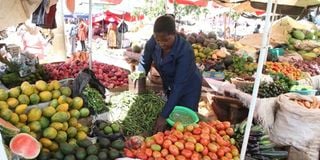Premium
Kenyans under more pressure as inflation rises to 9.2% in Feb

Tomato prices increased by 7.8 per cent compared to January while the prices of fresh unpacked milk increased by 2 per cent, according to the KNBS.
Increasing food prices have continued to put households under pressure and raise the cost of living, with new data indicating that inflation climbed to 9.2 per cent in February, as some food costs went up to 11 per cent more than they did in January.
This is a reverse trend, coming after inflation slowed for three consecutive months to hit 9 per cent in January, after accelerating through 2022, seeing households struggle with a high cost of living.
On February 28, the Kenya National Bureau of Statistics (KNBS) Consumer Price Index (CPI) showed that in that month, food commodities contributed greatly to the high inflation, reflecting the pain Kenyans are enduring.
The KNBS CPI showed cabbages, carrots and sukuma wiki (kales) that among food items whose prices rose by highest rates were among food items whose prices rose by the highest rates.
The three commodities’ prices rose by over 11 per cent within just a month.
Tomato prices also increased by 7.8 per cent compared to January while the prices of fresh unpacked milk increased by 2 per cent, KNBS stated.
Households also felt pain refilling their cooking gas, whose price increased by 4.7 per cent in February compared to January, even as electricity prices fell by between 2.9 and 3.7 per cent on different user bands.
The KNBS also reported that wheat and maize flour prices fell by 2.4 per cent and 2.5 per cent, respectively, during the month, as the price of sugar came down by 3.2 per cent.
The 9.2 per cent inflation rate becomes the third highest rate recorded since last year, when Kenyans started feeling the heat of high commodity prices, and is a return to the red zone.
The inflation had eased from 9.1 per cent in December to 9 per cent in January, after highs of 9.5 per cent in November and 9.6 per cent in October- the highest rate in more than five years.
The inflation rate rose beyond Central Bank of Kenya’s (CBK) guided upper limit of 7.5 per cent mid 2022 and has remained up, triggering the CBK’s move to raise lending rates as a control measure.





